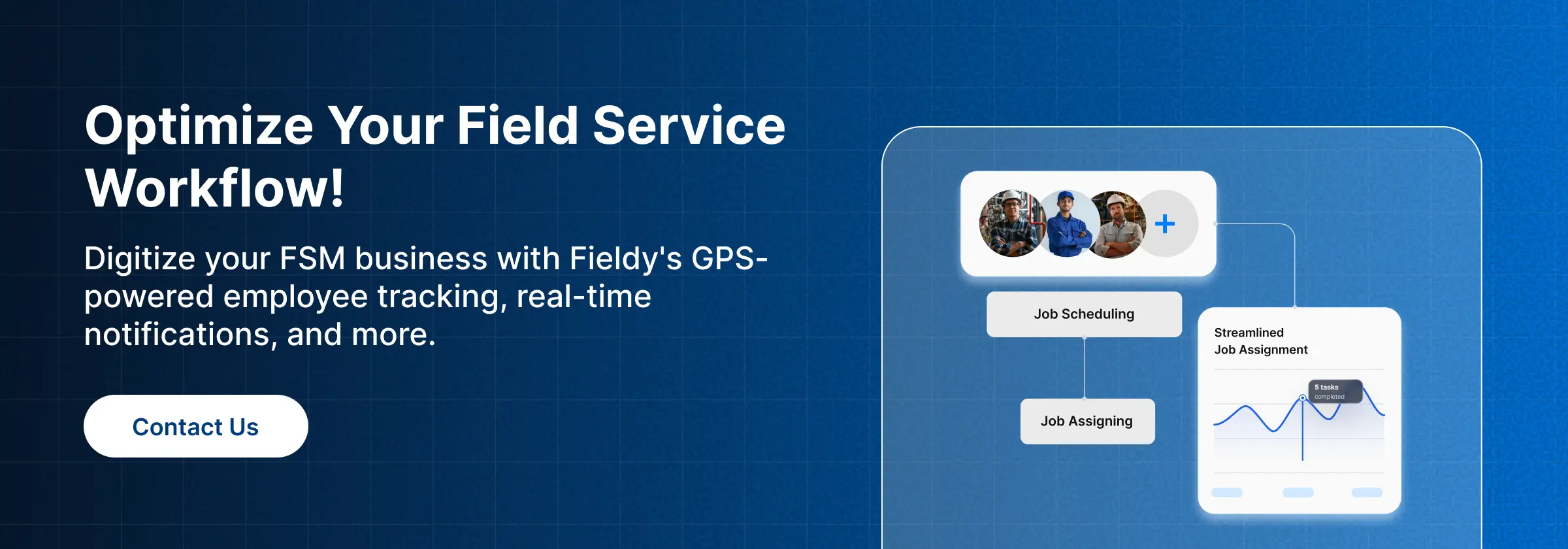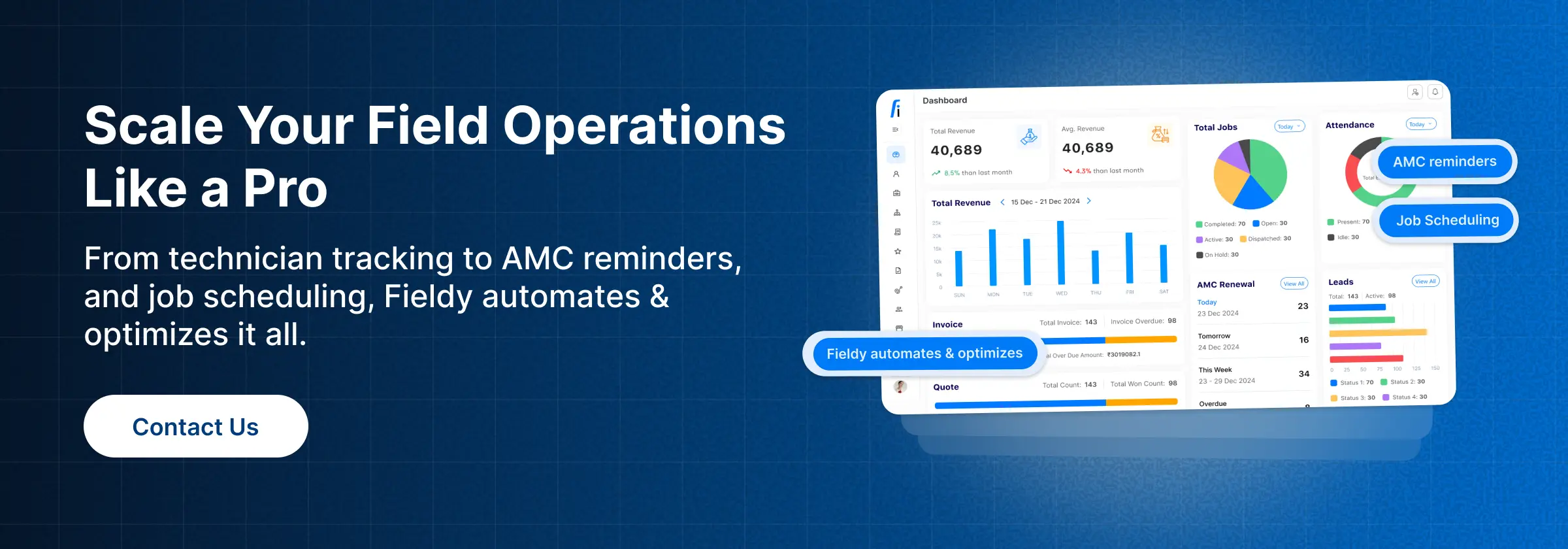Introduction
A defined workflow for field service is becoming a must in the context of the fast service economy today. Whether you are an HVAC technician working on teams around the block or running maintenance crews nationwide, emphasis rests on operational efficiencies.
Why Understanding Field Service Workflow Matters?
An efficient field service management workflow makes technicians more productive, enhances service satisfaction, and further supports field service business-critical metrics from first-time fix rates to SLA compliance. Gartner (2024) indicates that companies adopting workflows achieving themselves witness an increase of 25-30% in technician productivity, and issues get resolved 20% faster.
The service-giving industry benefits when it knows each step in the workflow, since such knowledge enables it to remove bottlenecks and errors to achieve a consistent and high-quality service experience.
Overview of a Standard Field Service Management Workflow
The field management workflow is a multiple-step process that guides each and every service task from initiation to post-service analysis. The specific processes might differ by industry; for instance, Heating, Ventilating, and Air-Conditioning (HVAC), plumbing, and security systems. Still, the base framework remains unchanged.
Such workflows provide visibility, traceability, and accountability to the whole service life cycle. Be it a regular maintenance service or an urgent repair, the field service management software comes in at every stage to reduce manual effort and enhance the consistency of service.
Key Stages of the Field Service Management Workflow
1. Service Request Creation
The FSM processes are initiated upon the submission of a request by the customer. It could be done through:
- Phone Call
- Website Form
- Through the Mobile App
- An automated IoT alert
Example: A customer furnishes the information that a given HVAC system is broken using a mobile app. This request will include the problem description, location, and the preferred time window for an appointment.
For modern-day organizations, capturing this data as and when it is created becomes very crucial. Hence, Fieldy-type integrated platforms help centralize these incoming requests in an instant.
2. Work Order Generation
On successful request submission, a digital work order is generated. The work order needs to include:
- Job ID and timestamp
- Customer details and location
- Basic problem summary
- Priority-level
- Type of equipment or parts required
FSM software will standardize this documentation so that nothing is omitted and help prepare the technicians.
3. Job Scheduling and Technician Assignment
The job gets assigned to an available technician by the dispatcher or the FSM software based on:
- Proximity
- Skill set and certifications
- Technician availability
Newer generation tools use field service scheduling software that is AI-driven and hence can help reduce idle time and better optimize job assignment. In 2025, 60% of service companies will be using automated dispatching to boost operational efficiency (Field Service News, 2025).
4. Technician Dispatch and Navigation
Once assigned, the technician will get a mobile notification with all job details and optimized route instructions.
- Real-time dispatch alerts
- GPS route planning
- ETA updates to customers
This helps minimize travel time and improves punctuality, both of which are huge factors in customer satisfaction.
5. On-Site Work Execution
Upon arrival, the technician registers check-in via the field service mobile app and starts the service task. Some of the typical steps are:
- Diagnosing
- Repairing or replacing the item
- Inspecting and performing maintenance on a scheduled basis
With Fieldy or a similar platform, technicians further have access to digital SOPs, safety checklists, and manuals, being able to upload:
- Photos, before and after
- Notes and status updates
- Part usage and time spent
This digital documentation improves technician accountability and service quality.
6. Completion of the Job and Customer Sign-off
After completing the work, technicians collect digital proof-of-work such as:
- Photos
- Customer e-signature
- Final notes and time logs
The information is then uploaded to the FSM platform for record-keeping.
Example: Fieldy allows the technicians to upload pictures, collect digital signatures within the app, and thereby ease the entire process.
7. Invoicing and Collection of Payments
An invoice is automatically generated upon sign-off and sent to the customer. Payment may be made via:
- Credit/debit card
- UPI or QR code payment
- Online bank transfer
Invoicing is often integrated with KPI dashboards, enabling companies to track:
- Job-to-cash time
- Revenue per technician
- Billing accuracy
8. Post-Service Feedback and Analysis
This last step completes the feedback loop. Customers are requested to provide:
- Ratings (CSAT/NPS)
- Written reviews
- Suggestions for improvements
FSM tools analyze feedback and generate reports of technician performance. This analysis serves as a base for:
- Enhancing the training programs
- Modifying the SOPs
- Developing customer service
How Automation Enhances Workflow Stages in Field Service Management?
Advantages of Automated Workflows:
Automation will be the prime mover for efficiency in 2025. From scheduling to invoicing, automation allows little manual intervention, thereby limiting human error. Some value additions include:
- Faster dispatching with AI recommendations
- Back-office teams and customers get real-time updates
- Error-free documentation under mobile checklists
- Smooth invoicing and payments
According to Service Council (2024), automated FSM platforms reduce resolution time by 20 to 25%, greatly enhancing operational throughput.
Workflow Example in a Real-World Setting:
Let’s see how this translates into plumbing:
| Stage | What Happens | How Fieldy Supports It |
|---|---|---|
| Request Creation | Customer reports a pipe leak via the app with a photo and details. | Auto-logs the request and routes it to the dispatcher. |
| Work Order | The dispatcher creates a digital job ticket with the location and issue summary. | Auto-generates structured work orders synced with the mobile app. |
| Scheduling | AI assigns the nearest qualified technician based on skill and availability. | Smart scheduling engine finds best-fit tech in real time. |
| Dispatch | The technician receives job details and GPS navigation with ETA. | Sends mobile notification and optimized route. |
| On-Site Execution | The technician inspects and replaces the pipe; logs work details. | Enables check-in, notes, photo uploads, and mobile job tracking. |
| Sign-Off | Customer signs digitally; technician uploads final proof-of-work. | Captures e-signature and stores all records automatically. |
| Invoicing | The invoice is auto-generated and sent with a payment link. | Sends branded invoice with digital payment options. |
| Feedback | The customer rates the job and leaves a review. | Prompts for CSAT/NPS and log feedback for analysis. |
Emerging Technologies Shaping Field Service Management Workflows in 2025
With technology evolving, field service management workflows are getting smarter and more proactive. Here are the trends considered the top ones:
- AI & Predictive Maintenance: AI looks at the past job data to predict a breakdown and suggest preventive actions
- IoT Integration: Smart devices (think sensor for HVAC) automatically raise a service request
- Augmented Reality (AR): Real-time guidance and collaboration with remote experts assisting company technicians for complex repairs
Stat: According to IDC analysis (2025), more than 70% of FSM providers are now using some combination of AR, AI, or IoT to improve the performance of their fieldworkers and cut down on the time taken in performing diagnostic functions.
Speed is definitely a big factor with these technologies, but they also ensure more transparency, safety, and even a better experience for the customer.
Final Thoughts
“Optimizing Every Workflow Stage with the Right Tools”
Now more than ever, a well-structured field service management workflow becomes a competitive necessity. Throughout every stage in its implementation, services request a job analysis. The completion of the work itself ensures the growth of technicians, building customer goodwill, and business. Service providers in 2025 must remain enabled with the smart and automated FSM platform that supports:
- End-to-end job lifecycle management
- Real-time updates and notifications
- Seamless technician-customer communication
- KPI tracking and reporting
See how Fieldy helps you automate and manage every stage of your field service workflow. Book a Free Demo today.
FAQs:
What do you mean by a field service management workflow?
A: The field service management workflow means a sequential set of processes from the moment a service request is filed until the post-service review takes place. It ensures that scheduling, dispatching, execution, invoicing, and analysis all take place in an orderly, efficient, and traceable manner of interpretation.
Why should field service workflows exist in 2025?
A: Well-documented workflows raise the technician’s productivity, cut response time being cut short, and first-time fix rate. With customer expectations growing higher, something streamlined needs to become a business to achieve an undivided focus on its service.
What are some instances of automation in FSM platforms?
A: Examples include AI-driven technician scheduling, invoicing after job completion, IoT-triggered service requests, and real-time notifications about dispatch and updates.
What kind of support can tools such as Fieldy provide to field service teams?
A: Fieldy supports every stage in the field service management workflow by providing capabilities such as real-time scheduling, mobile work orders, technician tracking, digital signatures, invoicing, and collection of customer feedback from one platform.
Do field service management workflows vary from industry to industry?
A: Yes. While the core field service management workflow may be consistent, industries may incorporate specialized SOPs or parts management, or regulatory compliance steps into their workflows, such as HVAC, plumbing, security, and IT support.
What kind of metrics can FSM software track?
A: Metrics tracked by FSM software include job-to-cash cycle, first-time fix rate, technician utilization, customer satisfaction scores (CSAT/NPS), and billing accuracy.
How does IoT influence modern field service management workflows?
A: IoT-enabled devices can generate alarms automatically when maintenance is due, thus creating service requests that do not require manual entry. This allows firms to be in a reactive-to-proactive mode of service.
What are the next technologies that can shape field service management workflows?
A: In 2025, AI, IoT, and AR will be the top emerging technologies. They will allow predictive maintenance, remote troubleshooting, and smarter job scheduling, which will translate to faster resolution and better customer experience.


![What Are the Various Stages of Field Service Management Workflow? [Ultimate Guide for 2025]](https://blog-admin.getfieldy.com/wp-content/uploads/2025/08/Stages-of-Field-Service-Management-Workflow.webp)

